This is a list of Norwegian military equipment of World War II. This list will mainly focus on the equipment of the Norwegian army during the Norwegian campaign or World War II invasion of Norway by Nazi Germany. For Norwegian resistance or other Norwegian forces after the German occupation of Norway please put them under different headers to differentiate them or put them in a different list.

Operation Alphabet was an evacuation, authorised on 24 May 1940, of Allied troops from the harbour of Narvik in northern Norway marking the success of Operation Weserübung and the end of the Allied campaign in Norway during World War II. The evacuation was completed by 8 June.
The Battles of Narvik were fought from 9 April to 8 June 1940, as a naval battle in Ofotfjord and as a land battle in the mountains surrounding the north Norwegian town of Narvik, as part of the Norwegian Campaign of the Second World War.

The Heinkel He 115 was a three-seat World War II Luftwaffe seaplane. It was used as a torpedo bomber and performed general seaplane duties, such as reconnaissance and minelaying. The aircraft was powered by two 960 PS BMW 132K nine-cylinder air-cooled radial engines. Some later models could seat four, had different engines or used different weapon arrangements.
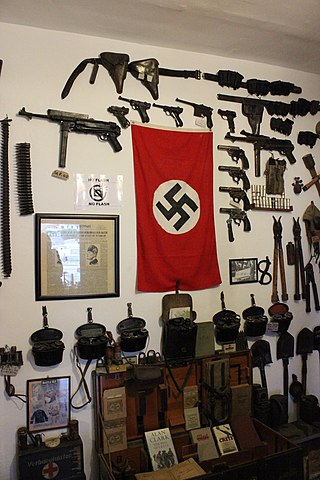
Lists of World War II military equipment are lists of military equipment in use during World War II (1939–1945). They include lists of aircraft, ships, vehicles, weapons, personal equipment, uniforms, and other equipment. There are aggregated military equipment lists by country, and lists of classes of equipment broken down by country or by type.

Sweden maintained its policy of neutrality during World War II. When the war began on 1 September 1939, the fate of Sweden was unclear. But by a combination of its geopolitical location in the Scandinavian Peninsula, realpolitik maneuvering during an unpredictable course of events, and a dedicated military build-up after 1942, Sweden kept its official neutrality status throughout the war. At the outbreak of hostilities, Sweden had held a neutral stance in international relations for more than a century, since the end of the Napoleonic Wars in 1814 and the invasion of Norway.
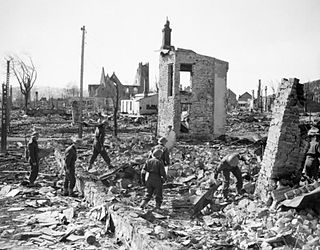
The Namsos campaign, in Namsos, Norway, and its surrounding area involved heavy fighting between Anglo-French and Norwegian naval and military forces on the one hand, and German military, naval and air forces on the other in April and early May 1940. It was one of the first significant occasions during the Second World War when British and French land forces fought the German Army.

The occupation of Norway by Nazi Germany during the Second World War began on 9 April 1940 after Operation Weserübung. Conventional armed resistance to the German invasion ended on 10 June 1940, and Nazi Germany controlled Norway until the capitulation of German forces in Europe on 8 May 1945. Throughout this period, a pro-German government named Den nasjonale regjering ruled Norway, while the Norwegian king Haakon VII and the prewar government escaped to London, where they formed a government in exile. Civil rule was effectively assumed by the Reichskommissariat Norwegen, which acted in collaboration with the pro-German puppet government. This period of military occupation is, in Norway, referred to as the "war years", "occupation period" or simply "the war".

The Battle of Midtskogen was a minor battle fought on the night of 9–10 April 1940 during the Second World War between a German raiding party and an improvised Norwegian force. The site of the battle was Midtskogen Farm, approximately 5 km (3.1 mi) west of the town of Elverum at the mouth of the Østerdalen valley in southern Norway. The invading German troops aimed to capture King Haakon VII and his cabinet, thereby forcing Norway into submission. After a short battle, the German force withdrew, having lost its commander in the fighting.
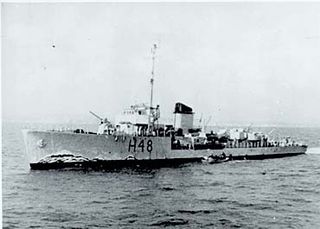
The Sleipner class was a class of six destroyers built for the Royal Norwegian Navy from 1936 until the German invasion in 1940. The design was considered advanced for its time, and it was the first class of vessels for the Norwegian Navy that used aluminium in the construction of the bridge, the mast and the outer funnel. Extra strength special steel was used in the construction of the hull. Unlike the earlier Draug class the Sleipner class had comparatively good capabilities in both main guns, anti-aircraft artillery and anti-submarine weapons. The class was named after Sleipnir, the eight-legged horse of Odin.
The Battle of Vinjesvingen was a battle of the Norwegian campaign and took place in May 1940 in the Telemark county, Norway. It became one of the two last strongholds of Norwegian resistance in southern Norway during World War II, the other being Hegra Fortress.
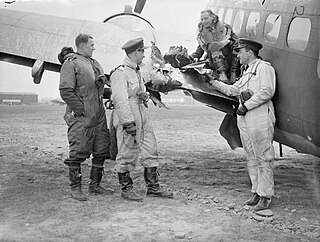
The Åndalsnes landings were a British military operation in 1940, during the Norwegian Campaign of World War II. Following the German invasion of Norway in April 1940, a British Army expeditionary force was landed at Åndalsnes, in Romsdal, to support Norwegian Army units defending the city of Trondheim. British forces were also landed at Namsos, north of Åndalsnes, in a complementary pincer movement. The British landings were unsuccessful and the Allies suffered a significant defeat at Åndalsnes.
This is a list of World War II-related topic lists:

The German invasion of Denmark, was the German attack on Denmark on 9 April 1940, during the Second World War. The attack was a prelude to the invasion of Norway.

The Motorised Submersible Canoe (MSC), nicknamed Sleeping Beauty, was built by the British Special Operations Executive (SOE) during World War II as an underwater vehicle for a single frogman to perform clandestine reconnaissance or attacks against enemy vessels.

Operation Weserübung was the invasion of Denmark and Norway by Nazi Germany during the Second World War and the opening operation of the Norwegian Campaign.
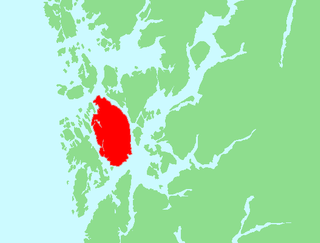
Operation Cartoon was a British Commando raid on the island of Stord near Leirvik in Vestland, Norway on the night of 23/24 January 1943. The operation was carried out by 53 men of No. 12 Commando supported by ten men from the Norwegian 10 (IA) Commando. RAF Coastal Command co-operated with the Commandos, with aircraft from 18 Group.
The Battle of Høljarast Bridge was a military engagement between Norwegian and German forces during the Norwegian Campaign. The battle ended with a partial Norwegian defeat as they were unable to hold their lines against German advance. Norwegians managed to withdraw in order destroying the strategic bridge so Germans would not be able to use it. Germans soon built an improvised bridge in the same place they named "Brandenburg".

SS Hestmanden is a Norwegian steamer, which since 2017 is the travelling museum ship Norsk krigsseilermuseum. Hestmanden is the only preserved cargo ship that has sailed in convoys during both World War I and World War II. It is the only remaining ship of the more than 1,000 that were part of the Nortraship fleet during World War II, and therefore represents a central part of Norway's war history and maritime history. Called "the lucky ship", as it survived convoys in two world wars, Hestmanden is considered Norway's most valuable veteran ship.

The Battle of Fornebu was an engagement that occurred on 9 April 1940 during Operation Weserübung when the Germans launched an assault on Oslo, the capital of Norway. Seven fighter planes from the vastly outnumbered Norwegian Army Air Service took to the skies to engage the German forces and managed to shoot down four planes against the loss of one before running out of fuel.